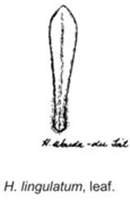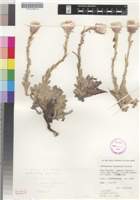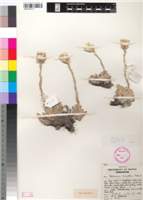Origin of name:
lingulatum = tongue shaped refers to leaves.
Diagnostic characters:
RosettesLarge solitary headsPink-white bractsWoolly leaves
Description:
Mat-forming perennial herb with many crowded leaf rosettes from woody well-branched underground stems up to 10 mm diam., flowering stems terminal to each rosette, solitary, up to 180 mm tall, grey-woolly, leafy. Radical leaves up to 35 x 8 mm, lingulate, apex rounded, both surfaces closely grey-woolly; cauline leaves mostly narrowly elliptic, tipped with a white scarious bract. Heads homogamous or heterogamous, campanulate, c. 20 mm long, nearly double that across the radiating bracts, solitary. Involucral bracts in c. 7 series, graded, loosely imbricate, much exceeding the flowers, glossy, tinged delicate pink initially, fading to white, crimson blotch inside near base. Receptacle shortly honeycombed. Flowers 152�180, 0�12 female, 152�170 homogamous. Achenes 1.5 mm, barrel-shaped, with myxogenic duplex hairs. Pappus bristles many, tips barbellate, bases cohering by patent cilia, some fusion in bundles as well.
Flowering in September and October.
Distribution:
Forms large mats on hard bare earth or in stony turf. Scanty records only from Underberg district in Natal, Mt Fletcher and Engcobo districts in Transkei, Maclear district in the E. Cape, and Qacha's Nek and Ramatseliso's Gate in Lesotho, between c. 1 500 and 1 950 m.
Grassland Biome.
Notes:
Can be confused with H. argentissimum but that species has linear or linear-lanceolate leaves with silky indumentum.
Taxonomy:
Literature:
Helichrysum lingulatum Hilliard in Notes R. bot. Gdn Edinb. 32: 352 (1973), Compositae in Natal 238 (1977).
Type:
Cape, Maclear distr., summit Pot River Pass, c. 1 950 m, Hilliard 5173 (NU, holo.; E; K; M; MO; NBG; PRE; S, iso.).
Synonym(s):
Vouchers:
Coleman 640 (NU); Esterhuysen 29166 (BOL); Hilliard & Burtt 13103 (E; K; NU; PRE; S); Jacottet 35 (G); Werdermann & Oberdieck 1116 (K).



